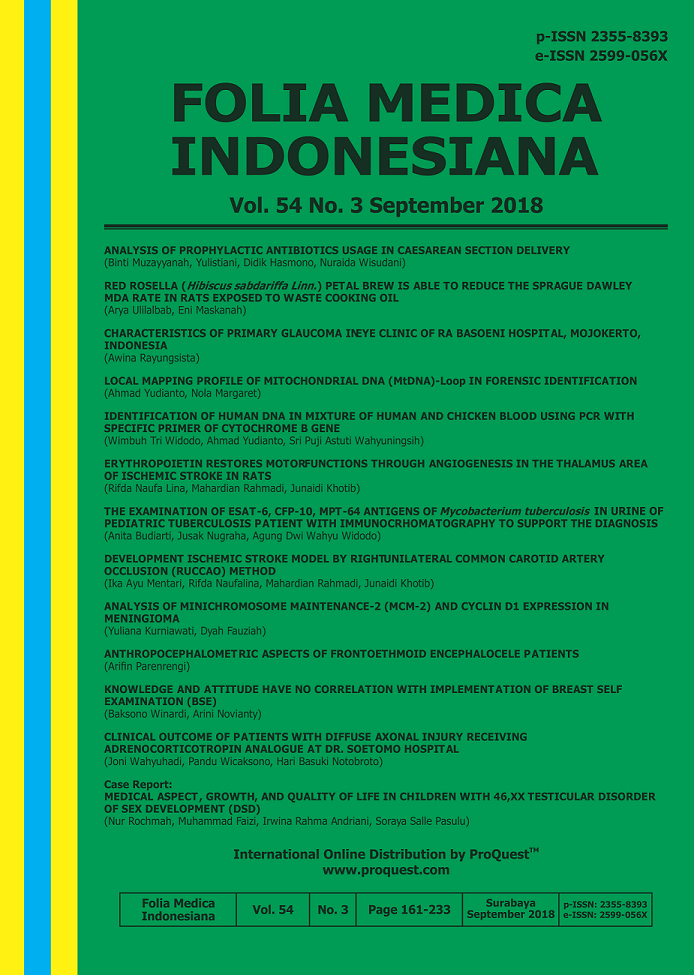Main Article Content
Abstract
Keywords
Article Details
-
Folia Medica Indonesiana is a scientific peer-reviewed article which freely available to be accessed, downloaded, and used for research purposes. Folia Medica Indonesiana (p-ISSN: 2541-1012; e-ISSN: 2528-2018) is licensed under a Creative Commons Attribution 4.0 International License. Manuscripts submitted to Folia Medica Indonesiana are published under the terms of the Creative Commons License. The terms of the license are:
Attribution ” You must give appropriate credit, provide a link to the license, and indicate if changes were made. You may do so in any reasonable manner, but not in any way that suggests the licensor endorses you or your use.
NonCommercial ” You may not use the material for commercial purposes.
ShareAlike ” If you remix, transform, or build upon the material, you must distribute your contributions under the same license as the original.
No additional restrictions ” You may not apply legal terms or technological measures that legally restrict others from doing anything the license permits.
You are free to :
Share ” copy and redistribute the material in any medium or format.
Adapt ” remix, transform, and build upon the material.

References
- Agarwal R, et al (2009). Current concepts in the patho-physiology of glaucoma. Indian J Ophthalmol 57, 257-266
- American Academy of Ophthalmology Staff (2016). Basic and clinical science course: Glaucoma. San Fransisco, AAO
- Bourne R, et al (2003). Prevalence of glaucoma in Thailand: A population based survey in Rom Klao District, Bangkok. Br J Ophthamol 87, 1069-1074
- Cheng JW, et al (2014). The prevalence of primary angle closure glaucoma in adult Asians: A systematic review and meta-analysis. Plos One 9, 1-9
- Ilyas S et al (2002). Ilmu penyakit mata untuk dokter umum dan mahasiswa kedokteran. Jakarta, Sagung Seto
- Klein BE, et al (1992). Prevalence of glaucoma. The Beaver Dam Eye Study. Ophthalmology 99, 1499-1504
- Markowitz SN, Morin JD (1984). Angle-closure glaucoma: Relation between lens thickness, anteri-or chamber depth and age. Can J Ophthalmol 19, 300-2
- Ministry of Health's Data and Information Center (2014). Situasi gangguan penglihatan dan kebutaan. Jakarta, Kementerian Kesehatan RI
- Ramakrishnan R et al (2003). Glaucoma in a rural population of Southern India: The aravind compre-hensive eye survey. Ophthalmology 110, 1484-1480
- Riordan-Eva P, John W (2009). Vaughan & Ashbury: Oftalmologi Umum. Jakrta: ECG
- Saccí SC, et al (2016). From DNA damage to functional changes of the trabecular meshwork in aging and glaucoma. Ageing Research Reviews. http://dx.doi.org/10.1016/j.arr.2016.05.012. Accessed August 17, 2017
- Song W, et al (2011). Prevalence of glaucoma in a rural Northern China adult population a population-based survey in Kailu County, Inner Mongolia. Ophthalmology 118, 1982-1988
- Thapa SS, et al (2012). A population-based survey of the prevalence and types of glaucoma in Nepal: The Bhaktapur glaucoma study. Ophthalmolgy 9, 759-764
- Tehrani S (2014). Gender Difference in the pathophysi-ology and treatment of glaucoma. Current Eye Research 40, 191-200
- Tielsch JM, et al (1991). Racial variations in the prevalence of primary open-angle glaucoma. The Baltimore Eye Survey. JAMA 266, 369-374
- WHO (2014). Visual impairment and blindness. Available from http://www.who.int/mediacentre/fact-sheets/fs282/en/. Accessed August 15, 2017
References
Agarwal R, et al (2009). Current concepts in the patho-physiology of glaucoma. Indian J Ophthalmol 57, 257-266
American Academy of Ophthalmology Staff (2016). Basic and clinical science course: Glaucoma. San Fransisco, AAO
Bourne R, et al (2003). Prevalence of glaucoma in Thailand: A population based survey in Rom Klao District, Bangkok. Br J Ophthamol 87, 1069-1074
Cheng JW, et al (2014). The prevalence of primary angle closure glaucoma in adult Asians: A systematic review and meta-analysis. Plos One 9, 1-9
Ilyas S et al (2002). Ilmu penyakit mata untuk dokter umum dan mahasiswa kedokteran. Jakarta, Sagung Seto
Klein BE, et al (1992). Prevalence of glaucoma. The Beaver Dam Eye Study. Ophthalmology 99, 1499-1504
Markowitz SN, Morin JD (1984). Angle-closure glaucoma: Relation between lens thickness, anteri-or chamber depth and age. Can J Ophthalmol 19, 300-2
Ministry of Health's Data and Information Center (2014). Situasi gangguan penglihatan dan kebutaan. Jakarta, Kementerian Kesehatan RI
Ramakrishnan R et al (2003). Glaucoma in a rural population of Southern India: The aravind compre-hensive eye survey. Ophthalmology 110, 1484-1480
Riordan-Eva P, John W (2009). Vaughan & Ashbury: Oftalmologi Umum. Jakrta: ECG
Saccí SC, et al (2016). From DNA damage to functional changes of the trabecular meshwork in aging and glaucoma. Ageing Research Reviews. http://dx.doi.org/10.1016/j.arr.2016.05.012. Accessed August 17, 2017
Song W, et al (2011). Prevalence of glaucoma in a rural Northern China adult population a population-based survey in Kailu County, Inner Mongolia. Ophthalmology 118, 1982-1988
Thapa SS, et al (2012). A population-based survey of the prevalence and types of glaucoma in Nepal: The Bhaktapur glaucoma study. Ophthalmolgy 9, 759-764
Tehrani S (2014). Gender Difference in the pathophysi-ology and treatment of glaucoma. Current Eye Research 40, 191-200
Tielsch JM, et al (1991). Racial variations in the prevalence of primary open-angle glaucoma. The Baltimore Eye Survey. JAMA 266, 369-374
WHO (2014). Visual impairment and blindness. Available from http://www.who.int/mediacentre/fact-sheets/fs282/en/. Accessed August 15, 2017

